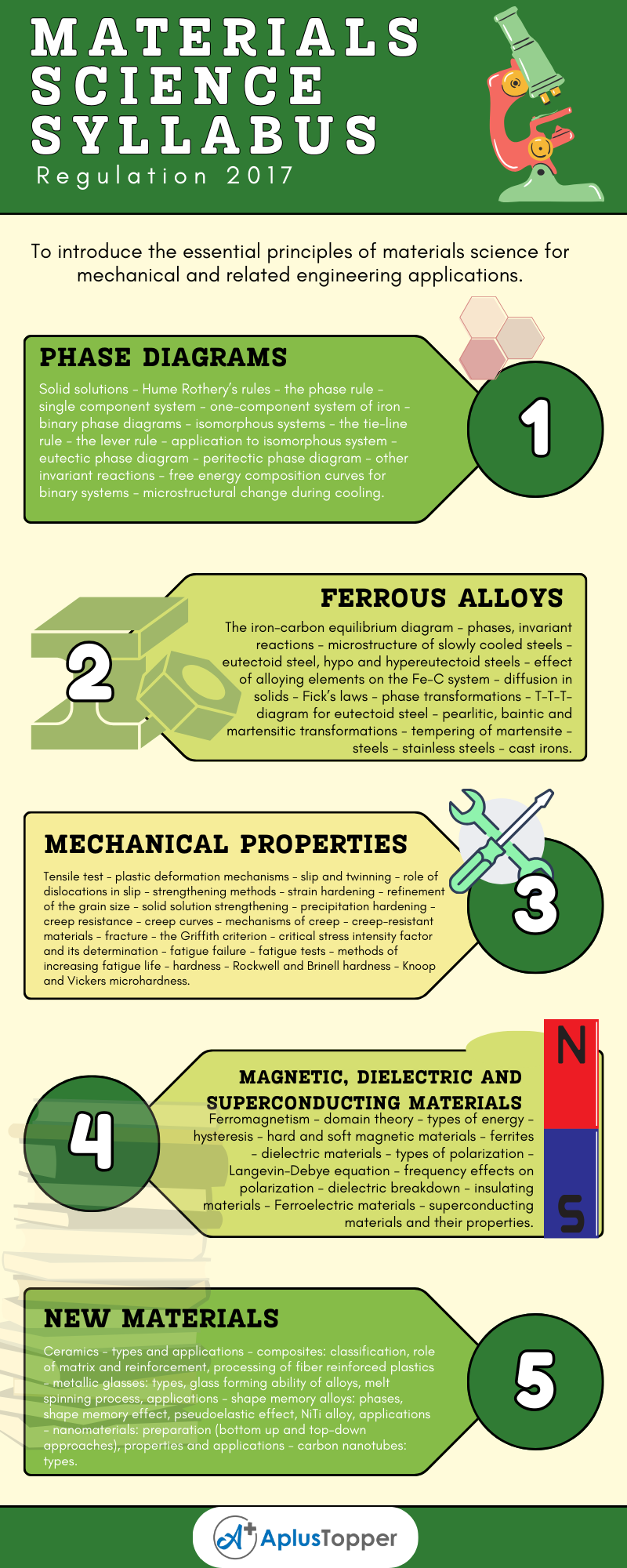Code –PH8251, this article about B.E/B.Tech./B.Arch Mechanical Engineering Semester II Materials Science syllabus. Students are requested to make notes or PDFs of the semester in Materials Science for effective preparation from here. It will help you to understand what are the topics in the syllabus of Materials Science.
And to make preparation strategies to score well in the examinations. Unit-wise detailed syllabus is given below in one place, in the following article PH8251 – Materials Science. If the information helps you, kindly share it with your classmates.
If you want to know more about the syllabus of B.E Mechanical Engineering connected to an affiliated institution’s four-year undergraduate degree programme. We provide you with a detailed Year-wise, semester-wise, and Subject-wise syllabus in the following link B.E Mechanical Engineering Syllabus Anna University Regulation 2017.
Aim Of Concept:
To introduce the essential principles of materials science for mechanical and related engineering applications.
PH8251 – Materials Science Syllabus
(Common to courses offered in Faculty of MechanicalEngineering
Except B.E. Materials Science and Engineering)
Unit I: Phase Diagrams
Solid solutions – Hume Rothery’s rules – the phase rule – single component system – one-component system of iron – binary phase diagrams – isomorphous systems – the tie-line rule – the lever rule – application to isomorphous system – eutectic phase diagram – peritectic phase diagram – other invariant reactions – free energy composition curves for binary systems – microstructural change during cooling.
Unit II: Ferrous Alloys
The iron-carbon equilibrium diagram – phases, invariant reactions – microstructure of slowly cooled steels – eutectoid steel, hypo and hypereutectoid steels – effect of alloying elements on the Fe-C system – diffusion in solids – Fick’s laws – phase transformations – T-T-T-diagram for eutectoid steel – pearlitic, baintic and martensitic transformations – tempering of martensite – steels – stainless steels – cast irons.
Unit III: Mechanical Properties
Tensile test – plastic deformation mechanisms – slip and twinning – role of dislocations in slip – strengthening methods – strain hardening – refinement of the grain size – solid solution strengthening – precipitation hardening – creep resistance – creep curves – mechanisms of creep – creep-resistant materials – fracture – the Griffith criterion – critical stress intensity factor and its determination – fatigue failure – fatigue tests – methods of increasing fatigue life – hardness – Rockwell and Brinell hardness – Knoop and Vickers microhardness.

Unit IV: Magnetic, Dielectric And Superconducting Materials
Ferromagnetism – domain theory – types of energy – hysteresis – hard and soft magnetic materials – ferrites – dielectric materials – types of polarization – Langevin-Debye equation – frequency effects on polarization – dielectric breakdown – insulating materials – Ferroelectric materials – superconducting materials and their properties.
Unit V: New Materials
Ceramics – types and applications – composites: classification, role of matrix and reinforcement, processing of fiber reinforced plastics – metallic glasses: types, glass forming ability of alloys, melt spinning process, applications – shape memory alloys: phases, shape memory effect, pseudoelastic effect, NiTi alloy, applications – nanomaterials: preparation (bottom up and top-down approaches), properties and applications – carbon nanotubes: types.
Text Books:
- Balasubramaniam, R. “Callister’s Materials Science and Engineering”. Wiley India Pvt. Ltd., 2014.
- Raghavan, V. “Physical Metallurgy: Principles and Practice”. PHI Learning, 2015.
- Raghavan, V. “Materials Science and Engineering: A First course”. PHI Learning, 2015.
References:
- Askeland, D. “Materials Science and Engineering”. Brooks/Cole, 2010.
- Smith, W.F., Hashemi, J. & Prakash, R. “Materials Science and Engineering”.
- Tata McGraw Hill Education Pvt. Ltd., 2014.
- Wahab, M.A. “Solid State Physics: Structure and Properties of Materials”.
- Narosa Publishing House, 2009.
If you want to check the syllabus of other branches provided by Anna University, Anna University syllabus Regulation 2017 will assist you in a clear path. Hope you find the required details.
- HS8251 – Technical English Syllabus
- MA8251 – Engineering Mathematics – II Syllabus
- BE8253 – Basic Electrical, Electronics and Instrumentation Engineering Syllabus
- GE8291 – Environmental Science and Engineering Syllabus
- GE8292 – Engineering Mechanics Syllabus
- GE8261 – Engineering Practices Laboratory Syllabus
- BE8261 – Basic Electrical, Electronics and Instrumentation Engineering Laboratory Syllabus
